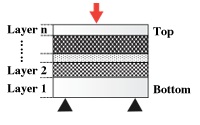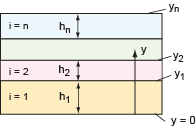 ) on a
property chart (e.g. Ef vs. ρ) allows direct comparison with all other
materials in the database.
) on a
property chart (e.g. Ef vs. ρ) allows direct comparison with all other
materials in the database.The structure of a multilayer leads to significant differences in properties in the in-plane and through-thickness directions. Only one direction can be specified in a selection project.
As a result, the values quoted on the material datasheet represent the performance in the direction that is most important for design. The direction important properties are specified if they are in-plane or through thickness. The exceptions are the permeability data, which are through-thickness properties.
In determining the calculations for the multilayer model, the following assumptions have been made:
The interfacial bond between layers is perfect, with no interfacial delamination occurring under loading.
The properties of the adhesive have little, or no, contribution to the overall panel properties (i.e. it has no thickness and no shear deformation occurs between the layers). If this is unreasonable (for instance with a very thin laminate) then it is possible to include an adhesive as a separate layer, either using a suitable existing record or creating a user defined record.
There is no shear deformation in any of the layers; the equations for flexural strength and stiffness assume no shear.
For thermal conductivity it is assumed that there is no thermal reflection at boundaries between layers (e.g. as can happen between ceramics and metals).
The calculations for flexural strength assume that the multilayer is loaded so that the top layer is in compression and the bottom layer in tension, the failure stress is calculated as the stress at which any one of the layers fails. The relative position of the layers is important for this calculation (for example, some materials such as wood and ceramics have a significantly different tensile and compressive strengths).
Due to the assumptions used, these models are not suitable for predicting the performance of laminates where significant levels of shear deformation occur in any of the layers, such as sandwich panels with low density cores. In these circumstances, it is more appropriate to use the balanced sandwich panel model.
Note: In order to compare multilayer materials with
conventional solid materials, it is necessary to consider them as a 'monolithic'
material with their own set of properties. This is achieved by calculating
the equivalent material properties for the multilayer. Plotting
these equivalent properties (e.g.  ) on a
property chart (e.g. Ef vs. ρ) allows direct comparison with all other
materials in the database.
) on a
property chart (e.g. Ef vs. ρ) allows direct comparison with all other
materials in the database.
In order to compare multilayer materials with conventional solid
materials, it is necessary to consider them as a 'monolithic' material
with their own set of properties. This is achieved by calculating
the equivalent material properties for the multilayer. Plotting
these equivalent properties (e.g.  ) on
a property chart (e.g. Ef
vs. ρ) allows direct comparison
with all other materials in the database.
) on
a property chart (e.g. Ef
vs. ρ) allows direct comparison
with all other materials in the database.
The equations used by the model to calculate the primary properties are summarized below. All calculated properties are equivalent properties. For more information on the derivation of these equations see derivation of calculations.
For a definition of the symbols used, see symbols.


Volume fraction of layer i

where yi is the distance from base of multilayer to top of layer i and so yn is the total height of the laminate.
Density

Price

Young's modulus

Flexural modulus





Yield strength (in-plane)


Flexural
strength, 


with σy,i equal to the yield or compressive strength depending on position of layer i relative to the neutral axis, and ydiff is the distance between the neutral axis and the edge of the layer that is experiencing the greatest stress.
Specific heat capacity

Thermal expansion (through-thickness)

Thermal conductivity (through-thickness)

Electrical resistivity (through-thickness)

Dielectric constant

Dielectric loss tangent

Water vapor transmission

Permeability (O2)

Embodied energy (primary production)

CO2 footprint (primary production)

A summary of the material properties required to calculate the equivalent multilayer properties is summarized in Table 1.
Table 1. Summary of properties required to calculate equivalent multilayer properties
| Calculated 'equivalent' property | Direction | Properties required by calculation |
|---|---|---|
| Density | - | Density |
| Price | - | Density Price |
| Young's modulus | In-plane | Young's modulus |
| Flexural modulus | - | Young's modulus |
| Yield strength | In-plane | Yield strength |
| Flexural strength | - | Yield strength Compressive strength |
| Specific heat capacity | - | Density Specific heat capacity |
| Thermal expansion coefficient | Through-thickness | Thermal expansion coefficient |
| Thermal conductivity | Through-thickness | Thermal conductivity |
| Electrical resistivity | Through-thickness | Electrical resistivity |
| Dielectric constant | - | Dielectric constant |
| Dielectric loss tangent | - | Dielectric loss tangent |
| Water vapor transmission | Through-thickness | Water vapor transmission |
| Permeability (O2) | Through-thickness | Permeability (O2) |
| Embodied energy | - | Embodied energy Density |
| CO2 footprint | - | CO2 footprint Density |
Copyright © 2019, Granta Design, Cambridge, UK